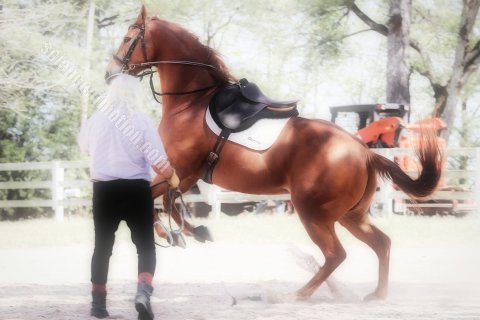Passive Aggressive
Passive Aggressive

These two words summarize modern equitation where the rider’s gluts are supported by the saddle high cantle and the rider’s thighs are stabilized by enormous thigh blocks. The rider is “placed” in a supposedly correct posture without adequate tone of his or her muscular system. Passive posture leads to aggressive gestures, legs actions, hand movements, shift of the rider’s weight, which, in regard of actual understanding of equine perception, are aggressing the horse senses. "And, especially, we must respect their integration of exquisite tactile sensitivity with a muscle power that can override any of our commands if we neglect to make our request meaningful, consistent and polite." (C. A. Saslow/ Applied Animal Behaviour Science)
From the antiquated beliefs that greater amplitude of gaits and performances results from muscles creating larger angular variations of the limbs joints, advanced understanding of equine locomotion and performances demonstrated that instead, “Most of the length change required for the work of locomotion, occurs not in the muscle fibers themselves but by elastic recoil of the associated tendons and muscles aponeurosis.” (The role of the extrinsic thoracic limb muscles in equine locomotion. R. C. Payne, P. Veenman and A. M. Wilson. J. Anat. (2005) 206, pp 193-404)
Harmonic tensegrity is the true dialogue with the horse. The gestures defined as the rider aids are the crude ends of subtle nuances in muscles tone orchestrated by our brain to create the move. The horse picks up all the nuances in muscle tone before the gesture is completed and is often disturbed by the gesture. Instead of regarding obedience to the rider aids as the finality of the equestrian art, the “aids” should be regarded as teaching techniques describing the subtle nuances in muscle tone that the horse perceives and process. Our ancestors promoted the refinements of the rider aids. Modern science suggests that the dialogue occurs at a more sophisticated level. “The seeming ability of a well-trained horse to have extrasensory perception for its rider’s intentions, may be instead its response to slight movement or tightening of muscles that the rider makes without awareness.” (C. A. Saslow. Applied Animal Behaviour Science 78 (2002) 209-234)
Horses are comfortable at a highly sophisticate level of perception. They are annoyed and often pushed to resistance and revolt when their senses are overloaded by the shifts of our body weight and other gestures. “Horses deemed insensitive to the leg (dead-sided) may simply have never had the chance to respond to consistent, light, meaningful signals.” (C. A. Saslow) The deep seat and high cantle saddles pushing the rider into a driving seat hamper the horse’s ability to subtly orchestrate the work of his back muscles which are set and function in opposite direction.
The concept of stimulus response is largely antiquated. A muscle never works alone. Each move is a complex network involving storage and reuse of elastic energy. Fascial tissues are commonly used for a dynamic energy storage, catapult action, during oscillatory movements such as walk, trot or canter. “During these movements, the supporting skeletal muscle contract more isometrically while the loaded fascial elements lengthen and shorten like elastic spring.” (Fukunaga & all, 2002) Simplistic concept such as rushing the horse forward hamper the horse’s ability to functions efficiently and soundly. Paraphrasing Margaret Mead, the horse brain must not be taught how to think, submission, but what to think, education. Guided by the rider’s subtle language, nuances in muscle tone and energy, the horse’s brain has to orchestrate close kinematics chains. “Every part of an organism, from the molecular to the gross anatomy, is integrated by a mechanical system into a complete functional unit.” (Dr. Stephen Levin, Orthopedic Surgeon.) Close kinematics chains combine multiple parts into continuous mechanical loops, which allows complex movements to be regulated by structure. “Close kinematics chains are very energy efficient. In the body, close kinematics chains are nested modular units of various sizes that make up an integrate movement system that extends throughout the whole body and acts in synergy with the nervous system.” (Dr. Betsy Uhl DVM, PhD, Dip, AVCP)
Fascia under tension is strong enough to maintain the integrity of the joints. Under tension fascia protect the cartilages “separating” the two sides of the joints. Muscles leverage against the fascia to optimize tension for each movement to stabilize and prevent overloading of the joints. Lines of force within the fascia change with muscular traction and bones movements. The whole system functions through tension, nuances in muscle tone elastic energy. Harmonic tensegrity, nuances in muscle tone, are fundamental tenures of the conversation between the horse and the riders. There is no room for slackness and lack of muscle tone. The rider who lets the intervertebral disks support the vertebrae, exposes his or her own vertebral column to damages. Fascia under tension protects the integrity of the vertebral structure reducing the pressure on the disks. From the gluts, the psoas and the upper thighs muscles, all the way up to the cervical vertebrae, the trapezius, the nuchal ligament, the verticality of the head, the whole rider body needs to be under harmonic tension. The conversation with the horse is the nuances in the muscle tones and consequent effect on all the systems allowing elasticity while preserving stability and integrity of the structures.
From its base, the seat, to its orchestrator, the brain, the rider’s body communicates with the horse through harmonic tensegrity. It is basically a conversation at the level of nuances in muscle tone and energy. The saddle needs to be the support of the rider’s tensegrity, not its alternative. When deep seat/high cantle saddles encourage slackness supporting the gluts. When knee pads and thighs blocks create a posture without adequate muscle tone, passivity extends to the vertebral column and the dialogue with the horse is downgraded to the aggressive level of gestures. Jean Luc Cornille


 twitter
twitter facebook
facebook google
google pinterest
pinterest linkedin
linkedin